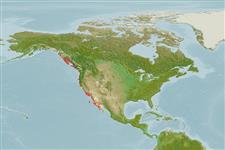Teleostei (teleosts) >
Carangaria/misc (Various families in series Carangaria) >
Sphyraenidae (Barracudas)
Etymology: Sphyraena: Greek, sphyraina, -es = the name of a fish (Ref. 45335).
More on author: Girard.
Environment: milieu / climate zone / depth range / distribution range
Ecology
Marine; pelagic-neritic; oceanodromous (Ref. 51243); depth range 0 - 18 m (Ref. 2850). Temperate; 58°N - 24°N, 155°W - 111°W
Eastern Pacific: Alaska to Magdalena Bay, Baja California. Not common north of Point Conception (Ref. 11484).
Size / Weight / Age
Maturity: Lm ? range ? - ? cm
Max length : 145 cm FL male/unsexed; (Ref. 40637); max. published weight: 12.0 kg (Ref. 40637); max. reported age: 12 years (Ref. 56049)
Usually near shore or near the surface (Ref. 2850). Often in small schools (Ref. 2850). Young enter bays (Ref. 2850). Feed mainly on other fishes (Ref. 2850). Pelagic spawners (Ref. 56049). Migrate south from the California coast during autumn, but may remain in front of the Mexican coast throughout the year (Ref. 9345). Utilized fresh, dried or salted and frozen; eaten broiled and baked (Ref. 9988). Considered as potentially dangerous due to its large, sharp teeth and aggressive disposition, though there are no reports of attacks (Ref. 9988).
Pelagic spawner (Ref. 56049).
Eschmeyer, W.N., E.S. Herald and H. Hammann, 1983. A field guide to Pacific coast fishes of North America. Boston (MA, USA): Houghton Mifflin Company. xii+336 p. (Ref. 2850)
IUCN Red List Status (Ref. 130435)
Threat to humans
Traumatogenic (Ref. 13513)
Human uses
Fisheries: commercial; gamefish: yes
Tools
Warning: mysqli::__construct(): (HY000/1040): Too many connections in /var/www/html/includes/speciessummary.lib.php on line 2104
Can't connect to MySQL database fbquizv2. Errorcode: Too many connections
